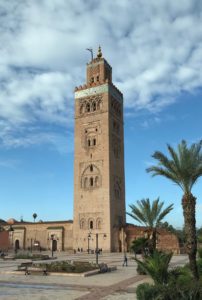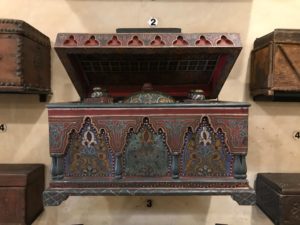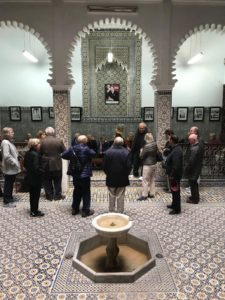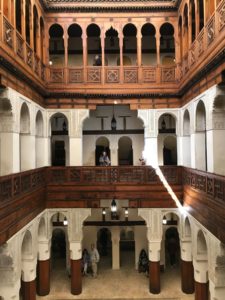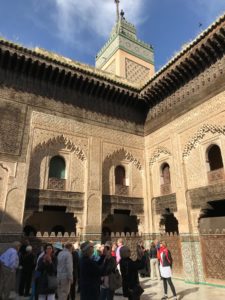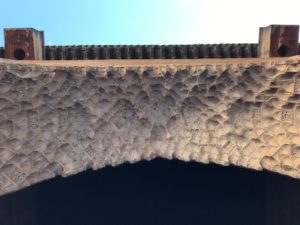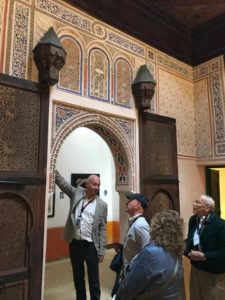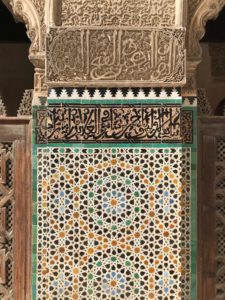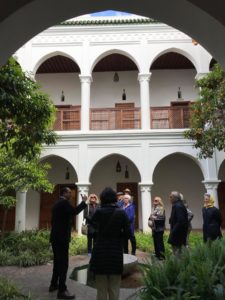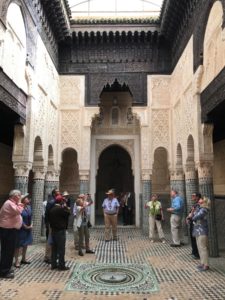Exploring Moroccan Design
EVENTS > STUDY TRIPS ABROAD
STUDY TRIP ABROAD SPRING 2019 IN REVIEW
The Trust’s early spring Study Trip Abroad to Morocco was our first foray outside of Europe and offered an opportunity to explore a fascinating and photogenic country with a rich cultural history stretching back two millennia. Located at the edge of northwestern Africa, Morocco is traditionally referred to as the Maghrib, or the “Land of the Setting Sun.” This region represented the frontier for ruling powers in Rome and the Arabian Peninsula, whose settlements extended westward and across the Strait of Gibraltar into Iberia.
Morocco’s architecture reflects the thorough cultural exchange created through seven centuries of Islamic rule over southern Spain. Portions of this region, known as Andalusia, for the Arabic “Land of the Vandals,” remained under Muslim control until the fall of the Nasrid kingdom of Granada in 1492. During the Almohad dynasty of the 12th and 13th centuries, caliph Abd el-Moumen and his grandson Yacoub el-Mansour began an ambitious building campaign while ruling the largest empire that ever existed in the Muslim west. The Almohads commissioned extraordinary mosques in Marrakech, Rabat, and Seville, each featuring a soaring minaret, in the same era that the early Gothic cathedrals of France were under construction.
An iconic style of architecture permeates throughout Morocco. The densely packed nature of the walled cities, known as medinas, necessitated an inward-facing type of building. Other than a decorated door or window surround opening into the cities’ narrow alleyways, the austere stuccoed and painted exteriors of these structures belie the ornate and airy quality of their private interiors. Within those walls, architects created settings that are both richly decorated and serene. Courtyards are surrounded by withdrawing rooms and arcaded galleries above. Of note are the grand medersas and riads, where private gardens were cultivated, a feature made possible by the Arabic engineers’ mastery of irrigation and hydraulics.
We encountered the talents of the Moroccan artisans at sites ranging from the 17th-century Medersa of Sultan About el Hassan in Salé to the early-20th-century Dar el Bacha in Marrakech. The four primary materials incorporated into their designs are stone, ceramic, plaster, and wood. These elements were harnessed to develop intricately ornamented surfaces floor to ceiling. The ornament executed in tilework (known as zellig) and carved stone, plaster, and cedar appear in three primary forms: geometric, floral, and epigraphic.
The geometry of tilework in the Arabic-Andalusian tradition appears with a steady repetition in design and color. We examined the evolution of zellig between earlier sites of the 16th and 17th centuries and those of the late 19th and early 20th, which suggested that designers continued to refresh the technique over time. For instance, earlier buildings incorporate a narrow range of colors (white, black, green, blue, red, and yellow) each of which has a defined meaning in Islamic culture. More recent structures included an expanded palette. The craftsmen who executed these patterns rendered symmetrical stars and flowers through the installation of thousands of small tiles. A visit to a ceramic factory in Fes allowed us to witness the process of creating the materials required to generate the vast fields of zellig.
Plaster offered Moroccan builders a flexible material to orchestrate decorative elements in the floral and epigraphic traditions. The carved plaster elements of mosques and medersas (Islamic schools) typically contains koranic scripture and was initially accented by colorful paint schemes, which has been lost through the constant exposure to the elements in open-air courtyards. The elaborately carved mourqanas, or honeycomb, designs found on ceilings and the intrados of lintels and arches are another extraordinary accomplishment of the Hispano-Moresque style executed in plaster, wood, or stone.
Moroccan decorative arts display intricate ornamentation as well, and active craft traditions developed in the primary urban centers. The museum field in the Maghrib could be described as archaic relative to Western standards, but the Museum of Wood in Fes displayed a variety of furnishings and architectural woodwork to contextualize the Moroccan interior. The museum is housed in the Fondouk el-Nejjarine, an 18th-century trading post and UNESCO World Heritage Site worth a visit to see the impressive arcaded interior. At the el-Badi Palace in Marrakech, an exhibit on the conservation of an extraordinary minbar, or pulpit, testifies to the link between Andalusia and Morocco. Constructed in Córdoba in the early 12th century and entirely clad in panels of intricate inlay, the minbar was used for eight centuries in the Koutoubia Mosque.
The movement to preserve and restore Morocco’s built environment appears to be in early stages. Proactive efforts were encountered in Tetouan, a city founded in the 15th century along the country’s Mediterranean coast by Muslim and Jewish refugees fleeing persecution in Christian Andalusia. Dr. Mhammad Benaboud is spearheading the local preservation effort and welcomed us to his family’s riad, which serves as the headquarters. His organization owns 6 buildings in the city as well as a school for traditional building arts. Dr. Benaboud explained the hierarchy of architectural space within the riad, which is similar to the function of entry halls, withdrawing rooms, and front and back parlors in European and American settings.
Expats from the Beatles to the Beatniks, have sought the exotic havens of Tangier and Marrakech. More recent immigrants are actively involved in preservation and adaptive-reuse projects, taking advantage of the country’s growing popularity as a tourist destination. French hotelier Patrick Manac’h, who also operates a museum of photography in Marrakech, purchased a turn-of-the-17th-century dwelling that is considered the best surviving example of domestic architecture produced under Morocco’s Saadian dynasty. Mr. Manac’h greeted us at the Museum Douira Mouassine and shared how he found the full decorative scheme intact under later layers of paint and plaster. The now-restored rooms would have served as a reception suite for the householder’s most important guests and reflect the elegance of Moroccan domestic architecture in the late 1500s.
For those who were unable to join us in Morocco, we strongly encourage you to take advantage of any opportunity to explore this incredible country. From ancient Roman ruins to the Yves Saint Laurent Museum, there is something for everyone.
Although the influence of architectural design from Morocco and Andalusia was never as prominent in the United States as Eurocentric styles, Moorish taste has appealed to Americans for two centuries. Elizabeth Humphrey from the University of Delaware’s Winterthur Program in American Material Culture received a Summer Research Grant in 2018 to further her exploration of Moorish Revival design in America. In her thesis, Moorish in the Midwest: The Alhambra’s Influence on Nineteenth-Century American Architecture, she analyzes these buildings and their patrons. Ms. Humphrey has documented more than 50 examples in the United States and links the popularity of the Arabic-Andalusian taste to the literature of Washington Irving (Tales from the Alhambra, 1839) and Mark Twain (Innocents Abroad, 1869); and the paintings of John Lafarge and Louis Comfort Tiffany when the exoticism of “Orientalist” subjects was in vogue.
NOTES:
1 These efforts enabled the ubiquitous public fountains encountered throughout the medinas as well as those inside ecclesiastical and secular buildings. In addition to serving as a necessity of life, water is a central component of the Islamic faith. Among the primary tenets of the religion, known as the five pillars of Islam, is the requirement of daily ablutions, the ritual washing of the face, arms, hands, and feet. The Mohammed VI Museum for the Water Civilization is a new museum in Marrakech devoted entirely to the country’s mastery of water management over the past millennia.
2 Humphrey, Elizabeth. “William Sauntry’s ‘Moorish Palace’: The Alhambra’s Influence on American Architecture,” The Magazine of the Decorative Arts Trust, Vol. 5, no. 2 (Winter 2018-2019), p. 19.
Complete a digital puzzle from this trip on our Puzzles webpage!

